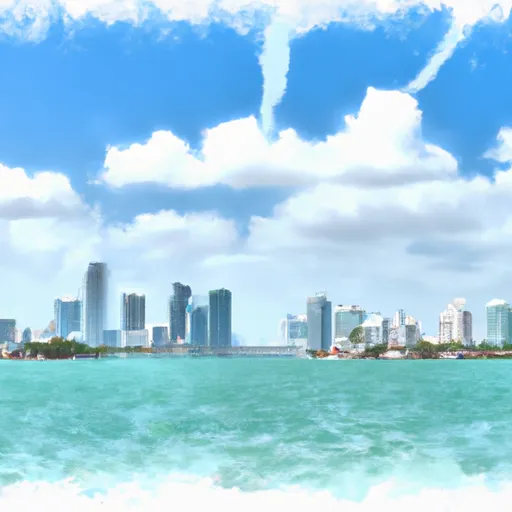-
 Snoflo Premium
Snoflo Premium
Get unlimited access to all our content
With no Ad interruptions! - Start Your Free Trial Login with existing account
Key-Biscayne
Eden Index
Climate
5.7
•
Recreation
4.2
•
Community
5.2
•
Safeguard
5.0/10

Key Biscayne is a beautiful island town located in Miami-Dade County, Florida. Known for its stunning beaches, lush parks, and year-round pleasant weather, the island offers a tropical climate and a variety of outdoor activities for residents and visitors alike.
The climate in Key Biscayne is characterized by hot and humid summers, with temperatures averaging in the high 80s to low 90s Fahrenheit (30-35 degrees Celsius), and mild winters, with temperatures ranging from the high 60s to low 70s Fahrenheit (15-20 degrees Celsius). The island receives abundant sunshine throughout the year, making it an ideal destination for outdoor enthusiasts.
Hydrologically, Key Biscayne is surrounded by the Atlantic Ocean and Biscayne Bay, offering numerous water-based activities such as swimming, snorkeling, diving, fishing, and boating. The island also features several parks and nature reserves, including Bill Baggs Cape Florida State Park, Crandon Park, and the Key Biscayne Nature Center. These areas provide opportunities for hiking, biking, picnicking, and wildlife watching.
Overall, Key Biscayne's climate, hydrology constituents, and outdoor recreation opportunities make it a popular destination for those seeking sun, sand, and natural beauty.
What is the Eden Index?
The Snoflo Eden Index serves as a comprehensive rating system for regions, evaluating their desirability through a holistic assessment of climate health, outdoor recreation opportunities, and natural disaster risk, acknowledging the profound impact of these factors on livability and well-being.
Climate Health Indicator (CHI): 5.7
Key-Biscayne receives approximately
1414mm of rain per year,
with humidity levels near 82%
and air temperatures averaging around
25°C.
Key-Biscayne has a plant hardyness factor of
11, meaning
plants and agriculture in this region tend to thrive here all year round.
By considering the ideal temperature range, reliable water supplies, clean air, and stable seasonal rain or snowpacks, the Climate Health Indicator (CHI) underscores the significance of a healthy climate as the foundation for quality living.
A healthy climate is paramount for ensuring a high quality of life and livability in a region, fostering both physical well-being and environmental harmony. This can be characterized by ideal temperatures, reliable access to water supplies, clean air, and consistent seasonal rain or snowpacks.
Weather Forecast
Streamflow Conditions
Southern Florida
Area Rivers
Southern Florida
Snowpack Depths
Southern Florida
Reservoir Storage Capacity
Southern Florida
Groundwater Levels
Recreational Opportunity Index (ROI): 4.2
The Recreational Opportunity Index (ROI) recognizes the value of outdoor recreational options, such as parks, hiking trails, camping sites, and fishing spots, while acknowledging that climate plays a pivotal role in ensuring the comfort and consistency of these experiences.
Access to outdoor recreational opportunities, encompassing activities such as parks, hiking, camping, and fishing, is crucial for overall well-being, and the climate plays a pivotal role in enabling and enhancing these experiences, ensuring that individuals can engage in nature-based activities comfortably and consistently.
Camping Areas
| Campground | Campsites | Reservations | Toilets | Showers | Elevation |
|---|---|---|---|---|---|
| CB Smith Park | None | 6 ft | |||
| Easterlin Park | None | 3 ft | |||
| Markham Park | 86 | 10 ft | |||
| Quiet Waters Park | None | 14 ft | |||
| Topeekeegee Yugnee County Park | 60 | 5 ft |
Catastrophe Safeguard Index (CSI):
The Catastrophe Safeguard Index (CSI) recognizes that natural disaster risk, encompassing floods, fires, hurricanes, and tornadoes, can drastically affect safety and the overall appeal of an area.
The level of natural disaster risk in a region significantly affects safety and the overall livability, with climate change amplifying these risks by potentially increasing the frequency and intensity of events like floods, fires, hurricanes, and tornadoes, thereby posing substantial challenges to community resilience and well-being.
Community Resilience Indicator (CRI): 5.2
The Community Resilience Indicator (CRI) recognizes that education, healthcare, and socioeconomics are crucial to the well-being of a region. The CRI acknowledges the profound impact of these elements on residents' overall quality of life. By evaluating educational resources, healthcare accessibility, and economic inclusivity, the index captures the essential aspects that contribute to a thriving community, fostering resident satisfaction, equity, and social cohesion.

